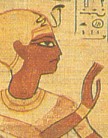
| |||||||
| High Priest of Amun ḥm nṯr tpj n jmn in hieroglyphs | |||||||
|---|---|---|---|---|---|---|---|
| Era: New Kingdom (1550–1069 BC) | |||||||
The High Priest of Amun or First Prophet of Amun (ḥm nṯr tpj n jmn) was the highest-ranking priest in the priesthood of the ancient Egyptian god Amun.[1] The first high priests of Amun appear in the New Kingdom of Egypt, at the beginning of the Eighteenth Dynasty.
The priesthood of Amun rose in power during the early Eighteenth dynasty through significant tributes to the god Amun by rulers such as Hatshepsut and more importantly Thutmose III.[2] The Amun priesthood in Thebes had four high-ranking priests:[3]
The power of the Amun priesthood was temporarily curtailed during the Amarna period. A high priest named Maya is recorded in year 4 of Akhenaten. Akhenaten had the name of Amun removed from monuments during his reign as well as the names of several other deities. After his death, Amun was restored to his place of prominence among the cults in Egypt. The young pharaoh Tutankhaten changed his name to Tutankhamun to signal the restoration of Amun to his former place of prominence.[4]
The Theban High Priest of Amun was appointed by the King. It was not uncommon for the position to be held by dignitaries who held additional posts in the pharaoh's administration. Several of the high priests from the time of Ramesses II also served as Vizier.[5]
At the end of the New Kingdom, the Twentieth Dynasty priesthood of Amun is for a large part dominated by Ramessesnakht. His son, Amenhotep, eventually succeeded his father and found himself in conflict with the Viceroy of Kush, Pinehesy. Pinehesy took his troops north and besieged Thebes. After this period, generals by the name of Herihor and Piankh served as High Priest.

By the time Herihor was proclaimed as the first ruling High Priest of Amun in 1080 BC—in the 19th Year of Ramesses XI—the Amun priesthood exercised an effective stranglehold on Egypt's economy. The Amun priests owned two-thirds of all the temple lands in Egypt and 90 percent of her ships plus many other resources.[6] Consequently, the Amun priests were as powerful as the pharaoh, if not more so. The High Priests of Amun were of such power and influence that they were effectively the rulers of Upper Egypt from 1080 to c. 943 BC, after which their influence declined. They are however not regarded as a ruling dynasty with pharaonic prerogatives, and after this period the influence of the Amun priesthood declined. One of the sons of the High Priest Pinedjem I would eventually assume the throne and rule Egypt for almost half a century as pharaoh Psusennes I, while the Theban High Priest Psusennes III would take the throne as king Psusennes II, the final ruler of the Twenty-first Dynasty of Egypt.
| Periods and dynasties of ancient Egypt |
|---|
|
All years are BC |


Though not officially pharaohs, the High Priests of Amun at Thebes were the de facto rulers of Upper Egypt during the Twenty-first dynasty, writing their names in cartouches and being buried in royal tombs.
| Name | Portrait | Comments | Dates |
|---|---|---|---|
| Herihor |  |
First High Priest of Amun to claim to be pharaoh. He ruled in the south in Thebes, while Ramesses XI ruled from the north in Pi-Ramesses. Some sources suggest he may have reigned after Piankh. | 1080–1074 BC |
| Piankh |  |
Some sources suggest he may have reigned before Herihor. | 1074–1070 BC |
| Pinedjem I |  |
Son of Piankh. Father of Psusennes I. | 1070–1032 BC |
| Masaharta |  |
Son of Pinedjem I. | 1054–1045 BC |
| Djedkhonsuefankh | — | Son of Pinedjem I. | 1046–1045 BC |
| Menkheperre |  |
Son of Pinedjem I. | 1045–992 BC |
| Nesbanebdjed II (Smendes II) |  |
Son of Menkheperre. | 992–990 BC |
| Pinedjem II |  |
Son of Menkheperre, Father of Psusennes II. | 990–976 BC |
| Pasebakhaennuit III (Psusennes III) | — | Possibly the same person as Psusennes II. Either he or Pinedjem II is generally considered to be the last High Priest of Amun to consider himself as a pharaoh-like figure. | 976–943 BC |

In the northern capital of Tanis, the pharaohs of the Twenty-first dynasty decided to openly emulate Karnak by building and expanding their own temple of Amun-Ra, along with shrines dedicated to the other members of the Theban Triad.[8]: 922 There are very few individuals known to have borne the mostly honorific title of High Priest of Amun at Tanis:[9]: 396